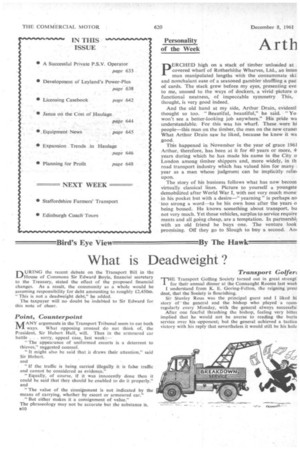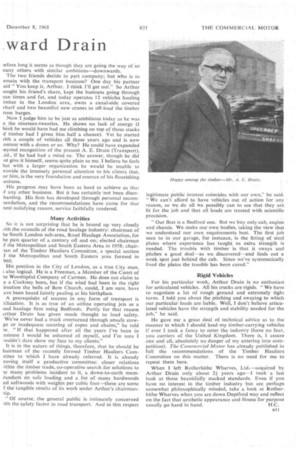Arth ward Drain
Page 44

Page 45

If you've noticed an error in this article please click here to report it so we can fix it.
pERCHED high on a stack of timber unloaded at covered wharf of Rotherhithe Wharves, Ltd., an inten man manipulated lengths with the consummate skii and nonchalant ease of a seasoned gambler shuffling a pac. of cards. The stack grew before my eyes, presenting eve: to me, unused to the ways of dockers, a vivid -picture functional neatness, of impeccable symmetry This, thought, is very good indeed.
And the old hand at my side, Arthur Drain, evidentl thought so too. " Beautiful, beautiful," he said. "Yes; won't see a better-looking job anywhere." His pride wa understandable. For this was his wharf. These were hi people—this man on the timber, the men on the new cranef What Arthur Drain saw he liked, because he knew it wa good.
This happened inNovember in the year of grace 1961 Arthur, therefore, has been at it for 40 years or more, 41 years during which he has made his name in the City o London among timber shippers and, more widely, in th road transport industry which has valued him for many year as a man whose judgment cart be implicitly reliel upon.
The story of his business follows what has now becom virtually classical lines. Picture to yourself a youngste demobilized after World War I, with not very much mane; in his pocket but with a desire—" yearning" is perhaps no too strong a word—to be his own boss after the years o being bossed. He knows something about transport, bu not very much. Yet those vehicles, surplus to service require ments and all going cheap, are a temptation. In partnershii with an old friend he buys one. The venture look promising. Off they go to Slough to buy a second. Am
efore long it seems as though they are going the way of so nany others with similar ambitions—downwards.
The two friends decide to part company; but who is to emain with the transport business? One day his partner aid "You keep it, Arthur. I think I'll get out." So Arthur aaught his friend's share, kept the business going through an times and fat, and today operates 12 vehicles hauling imber in the London area, owns a canal-side covered vharf and two beautiful new cranes to off-load the timber rom barges.
Now I judge him to be just as ambitious today as he was n the nineteen-twenties. He shows no lack of energy (1 hink he would have had me climbing on top of those stacks Pf timber had I given him half a chance). Yet he started rith a couple of vehicles all those years ago and is now ontent with a dozen or so. Why? He could have expanded leyond recognition of the present A. E. Drain (Transport), Ad., if he had had a mind to. The answer, though he did ot give it himself, seems quite plain to me. I believe he feels hat with a larger organization he would be unable to irovide the intensely personal attention to his clients that, or him, is the very foundation and essence of his flourishing ,usiness.
His progress may have been as hard to achieve as that f any other business. But it has certainly not been disenhanting. His firm has developed through personal recomlendation, and the recommendations have come for that lost satisfying reason, service faithfully rendered.
Many Activities So it is not surprising that he is bound up very closely iith the councils of the road haulage industry: chairman of he South London sub-area, Road Haulage Association, for he past quarter of a century off and on; elected chairman the Metropolitan and South Eastern Area in 1958; chair-tan of the Timber Hauliers Committee, a special section f the Metropolitan and South Eastern area formed in 960.
His position in the City of London, as a true City man, 3 also logical. He is a Freeman, a Member of the Court of he Worshipful Company of Carmen. He does not claim to
e a Cockney born, but if the wind had been in the right irection the bells of Bow Church, could, I am sure, have ave been heard faintly pealing at his birthplace.
A prerequisite of success in any form of transport is tilization. It is as true of an airline operating jets as a nad haulage firm using Bedfords. Partly for that reason krthur Drain has given much thought to load safety. We've never had a truck overturned through unsafe stowge or inadequate securing of ropes and chains," he told "If that happened after all the years I've been in usiness I would be ashamed of myself, and I'm sure I /ouldn't dare show my face to my clients."
It is in the nature of things, therefore, that he should be hairman of the recently formed Timber Hauliers Comlittee to which I have already referred. It is already roving itself a productive committee: closer relations iithin the timber trade, co-operative search for solutions to ie many pioblerns incident to it, a down-to-earth /nemrandum on safe loading and a list of •many hardwoods nd softwoods with weights per cubic foot—these are some f the tangible results of its work under Arthur's chairmanup.
"Of course, the general public is intimately concerned ,ith the safety factor in road transport. And in this respect
legitimate public interest coincides with our own," he said. "We can't afford to have vehicles out of action for any reason, so we do all we possibly can to see that they are fit for the job and that all loads are treated with scientific precision.
"Our fleet is a Bedford one. But we buy only cab, engine and chassis. We make our own bodies, taking the view that we understand our own requirements best. The first job seen to in our garage, for instance, is the fitting of steel plates where experience has taught us extra Strength is needed. The trouble with timber is that it sways and pitches a good deal—as we. discovered—and finds out a weak spot just behind the cab. Since we've systematically fixed the plates the trouble has been cured."
Rigid Vehicles
For his particular work, Arthur Drain is no enthusiast for articulated vehicles. All his trucks are rigids. "We have to negotiate a lot of rough ground and extremely tight turns. I told you about the pitching and swaying to which our particular loads are liable. Well, I don't believe articulated vehicles have the strength and stability needed for the job," he said.
He gave me a great deal of technical advice as to the manner in which I should load my timber-carrying vehicles if ever I took a fancy to enter the industry (have no fear, you carriers of the United Kingdom. There is, I assure one and all, absolutely no danger of my entering into competition). The Commercial Motor has already published in full the recommendations of the Timber Hauliers Committee on this matter. There is no need for me to repeat them here.
When I left Rotherhithe Wharves, Ltd.—acquired by Arthur Drain only about 21 years .ago—I took a last look at those beautifully stacked standards. Even if you have no interest in the timber industry but arc perhaps somewhat philosophically minded, take a look at Rotherhithe Wharves when you are down Deptford way and reflect on the fact that aesthetic appearance and fitness for purpose
Usually go hand in hand. H.C.




































































































































